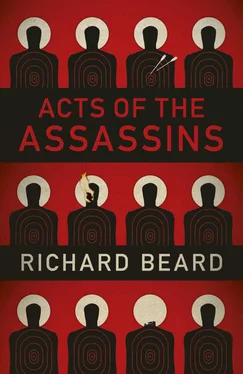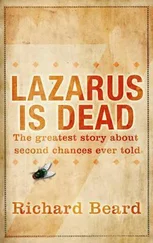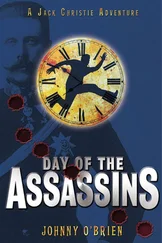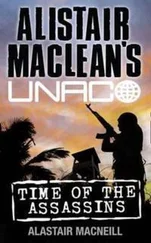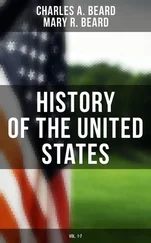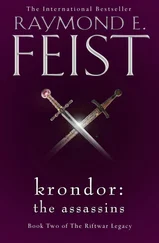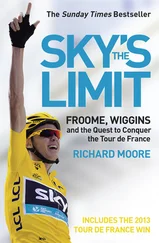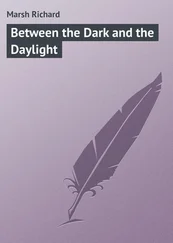The electricity clunks back on, and they shield their eyes from the light. Jude’s hands tremble, and his face is pale and bloodless. He’s dying, but Gallio will not be distracted. Jesus is alive or Jesus is dead. Only one of these statements can be true.
‘Is Jesus injured? How will I recognise him?’
‘I’ve told you what I know.’
‘The drugs, Jude. I’m thinking you want to save the little children.’
Jude rests his hand on Gallio’s shoulder, then pushes himself back to his feet. He has work to do. ‘You’re talking to the wrong disciple, my friend. Try Thomas. Take your doubts to doubting Thomas. He can tell you the truth.’
IV: THOMAS stoned and speared
THE BABYLON MORGUE is on the far side of the Euphrates bridge, next to police headquarters, a long hour’s drive from the airport. Baruch is silent, recovering from his second flight in two days, this time deep into the saddle of land between the Mediterranean and the Persian Gulf. Not a good flyer, Baruch. Gallio looks the other way, out of the reinforced window of the commandeered UN Land Cruiser.
Babylon never stops. The streets are crammed with bicycles weaving through cows and goats, the animals grazing at middens of household waste. Everyone in this city has something to do, somewhere to go, and if they could get there faster they would, to the exchange and markets, to the roadside traders with nimble hands who sort through car parts and electrical innards. There are so many people here, so many Babylonians, that Cassius Gallio finds it hard to believe in the sanctity of every life.
In his own way Cassius Gallio is a believer, not in divine oversight but in medical investment and the rule of law. The work of civilisation is rarely spontaneous, like a miracle, but it is solid and worth pursuing. The disciples with their superstitions threaten the status of civilised progress, because reason and observation insist that death is death. If Complex Casework let the Jesus mystery slide, along with the myth of his continued existence, they risk cultural suicide. Gallio feels he’s providing a genuine service by tracking down the truth about Jesus.
The Babylon police chief was at the airport to meet them, and on this occasion Cassius presented genuine CCU ID, issued to him by Valeria to establish his authority in Babylon. The embossed eagle to the side of his photo is a guarantee that he comes from the arrowhead of human evolution. Not just now but always. He has access to education and information that the citizens of Babylon can barely imagine.
The chief has pitch-dark eyebrows and sad green eyes. He knows the reality of international politics, where every lesser power owes allegiance to the dominant culture. He sighs, and from the front of the car he asks where first. ‘Morgue is closer than the crime scene. As instructed, we’ve sealed his apartment.’
‘Idiots,’ Baruch says. In the back seat of the Land Cruiser he fails to click his seatbelt, tries again, fails again, lets the belt recoil across his shoulder. ‘They’ve already moved him.’
Up front the chief shrugs, an elegant and foreign gesture. He doesn’t expect the advanced West to understand every nuance of the Old World. ‘We wanted to avoid hysteria. Thomas has built up quite a following.’
‘Morgue,’ Gallio decides. His instinct with the Jesus followers is to check they’re really dead. ‘Let’s see what’s left of the body.’
The morgue is underground to hide from temperatures that in summer can reach the forties. The broad lift is reserved for the dead (going down), but for the living the attendants burn incense in the spiral iron stairwell. Not quite enough of it. In the main underground autopsy room the overhead fan is stuck on slow, and stains watermark the ceiling above the walk-in fridges. In the centre of the room, a corpse on a steel trolley is covered in a green sheet. The sheet is too narrow and a naked arm, pale and sparsely haired, sticks out to the side.
Cassius Gallio approaches the trolley, while Baruch hangs back. They can’t be sure, not yet, that this isn’t a case of mistaken identity. It seems a grim coincidence for a second disciple to die so soon after James, and as at the Veronica souvenir shop Gallio senses other forces taking an interest. He hopes this isn’t so.
He stares at the thin exposed fingers. Thomas is the disciple who doubted the resurrection, which meant he helped convince the others it was true. According to Jude, Thomas put one or all of these fingers into the various wounds suffered by Jesus, who was crucified and came back from the dead.
Jude was probably lying.
Nevertheless, Gallio uses his imagination. Thomas would most likely have used his index finger, one of the fingers Gallio can see, and he supposedly placed it inside a five-day-old wound. Thomas would have had to go deep, to be sure of the severity of the injury, as far as the second knuckle at least, curving his finger past bones, inside the wet flesh. Waggle it from side to side, to make absolutely certain. Dead, alive. Dead and alive.
‘I could have made the bastard talk.’ With his feet back on solid ground, the memory of the aeroplane fading, Baruch is livening up. Poor Thomas, who for Baruch has let himself down by getting himself killed. Careless of him. Instead of lying here in the morgue he should have waited for Baruch, and been tortured before he died.
‘You’re seconded to CCU,’ Gallio reminds him. ‘We don’t encourage torture.’
‘Too real for you?’
‘Something like that.’
The murder of Thomas isn’t ideal. This is the disciple who persuaded the others that Jesus had come back to life. He was heavily complicit in the original lie. Peter and John were first into the tomb, but Thomas authenticated the wounds. Three or four disciples in this story were dominant, and they could have been used by Jesus to bully the others into believing, Thomas acting as a kind of insurance for anyone outside the loop who had doubts: Jesus died, Thomas assured them, and Jesus returned from the dead. For those disciples who weren’t in on the switch, and maybe not all of them were trusted, no one but Jesus had been crucified. No one but Jesus came back.
If Thomas was telling the truth, that is. Cassius Gallio will never know for sure, not now, not from the man himself. He takes the top seam of the sheet, stamped Babylon City Morgue , between his finger and thumb. Gallio is gentle with it, as if the green polyester were itself a living thing. He peels back the sheet.
It is him. It is Thomas. Gallio has no doubt about it, even though he looks like Jesus.
They could have arrived earlier, and Cassius Gallio could have saved the life of doubting Thomas, only Baruch had won the battle of the Jude debrief.
Back in Jerusalem their case room had been cleared of mops and buckets. An electrician was shooed away so they could talk, sitting on folding chairs round a trestle table. Pictures of Jesus had been pinned to the walls. Gallio squinted: images of Jesus, of disciples, hard at a glance to tell one from the other. Between two long windows a map of the ancient world was dotted with plastic pins for each confirmed sighting: eight so far.
Gallio opened the meeting by reporting on the intelligence he’d gained from Beirut. Essentially, though without being able to say when or how, Jude was convinced that Jesus was coming back.
‘What does that mean ?’ Valeria had her hands flat on the table, a signal everywhere in the world of straight-talking honesty.
‘Don’t know,’ Gallio had to admit, ‘but it sounds dramatic. Jude told me Jesus is coming back while at least one of his disciples is alive, so that’s our best idea of the timescale. Also that Thomas is operating out of Babylon. Our next step should be a visit to Thomas, interview him about the switch theory. Thomas has privileged information about the health status of Jesus in the period after the crucifixion.’
Читать дальше
